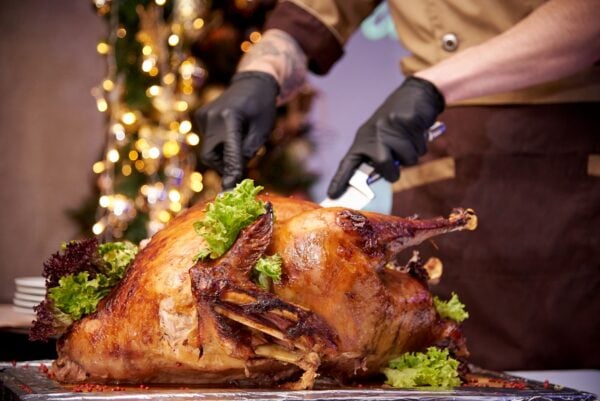
The Holidays have finally arrived, and that means it’s time to break out our carving tools. Luckily we only use these carving tools a few times a year. However, that means many of us are out of practice which leaves us more susceptible to injury.
The American Society for Surgery of the Hand reports that over 88% of Americans eat turkey on Thanksgiving, and that means A LOT of carving!
If you plan on being the Thanksgiving star this year by carving up the bird, help protect against injuries to your hand by following these simple safety tips…
Never Cut Towards Yourself
Your free hand should always be safely placed OPPOSITE the side that you are cutting towards. In other words, always keep both hands and your body out of the path of your cut.
Avoid placing your hand underneath the blade to catch the slice of meat
All of your surroundings should be dry! Your hands, your knife handles, your cutting board, as well as your surrounding cutting area or countertop. This helps avoid slips and slides that result in an injury! Everything should be dry… except your turkey! (haha)
Make sure your tools are sharp
This might sound silly, but using dull tools requires you to use more force to cut through your turkey. This makes you more likely to rip through or slip & slide around, cutting yourself. Sharp tools glide more easily through your meats.
Keep everything in your work space clean and dry
All of your surroundings should be dry! Your hands, your knife handles, your cutting board, as well as your surrounding cutting area or countertop. This helps avoid slips and slides that result in an injury! Everything should be dry… except your turkey! (haha)
Avoid using a knife to cut through bones
We all love to use the bones for either broth or making gravy. Try using your kitchen scissors instead. This is what kitchen scissors are designed for. They make the job both easier for you and more safe for your hands.
If you do have a turkey carving accident… Clean and keep continuous pressure on the wound. Seek immediate medical help if you are unable to stop the bleeding, you are unsure of your Tetanus status, or you are unable to thoroughly cleanse the wound. We often take advantage of our hands, don’t forget how important they are to your everyday life! We use them as our primary tools for exploring the world; an injury can permanently impact your home and work life. Please be safe this season.
Keep Reading…
BALANCING CALORIES AND ACTIVITY AROUND THE HOLIDAYS
The holidays revolve around spending time with friends and family creating new memories and partaking in timeless traditions. Much of the holiday season involves time spent sharing a meal together. With all of the parties, get-togethers, and time socializing around the table, it is easy to get carried away while indulging in appetizers, home-cooked meals, and treats native to the season. Below is a list of creative ways to get up and start moving to burn off those extra holiday calories! (Calories burned based on a 150-pound, 65 year old female):
SLOW THE PROGRESSION OF ARTHRITIS WITH NUTRITION
Slowing the Progression of Arthritis
It is increasingly apparent that what is healthy for one’s heart is also good for one’s aching joints and knees. Current research links significant associations between the types of dietary fat intake with structural progression of knee osteoarthritis. Osteoarthirits (OA) also known as degenerative joint disease (DJD) is the most common chronic condition of the joints affecting more than 3 million people a year or 27 million Americans. One in two adults will develop symptoms of OA in their lifetime (Arthritis Foundation, 2016). Common risk factors for developing arthritis include increasing age, previous joint injury, obesity, joint overuse, weak supporting muscles, and genes.
However, top researchers in the field of nutrition science affirm that following a healthy diet may be an effective strategy for the management of knee osteoarthritis. Furthermore, following a healthy diet and lifestyle is by far more attractive than medications with respect to (long term) risks/benefits. The results of the following study offer hope for individuals searching for steps to limit the progression of OA.
TOP 10 REASONS TO CHOOSE PT FIRST
Do more than mask the pain, reduce or eliminate it.
Exercise and manual therapy (including soft tissue and joint mobilizations) can help relieve pain, restore mobility and function and help reduce or eliminate pain. Pain is often cyclical and can be minimized or eliminated with musculoskeletal mobility.
Learn how to help treat yourself and become empowered with your care
There really isn’t a magic wand at PT! A Physical Therapist will do more than just address your injury or involved body part. We will look at you as a whole person and empower you with your care, giving you plenty of education and ways you can help yourself.
Become more active!
Learn to care for your body instead of suffer. There are so many studies that show that activity for 30 minutes per day helps to maintain healthy systems, from head to toe. A Physical Therapist promotes total health and wellness and can often be a good motivator to get you on track with your goals!
Prevent surgery
Often times, musculoskeletal injuries can be treated by PT and you can avoid surgery all together. The key is to get to know a PT soon after an injury so your pain and limitations do not become irreversible. Talk with your physician ASAP!
Free Community Education Seminar: Hip and Knee Pain
Join us for Hip and Knee Pain - the next seminar in our Free Community Education Series. This interactive seminar will feature Robert Sherman, MD of Upstate Orthopedics and Onondaga Physical Therapy's Taryn Bader, PT.






